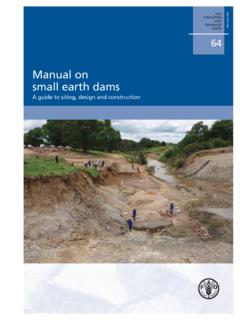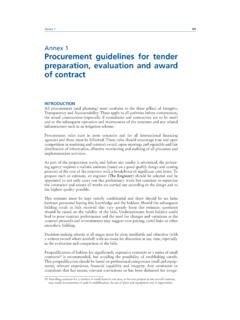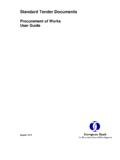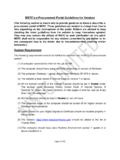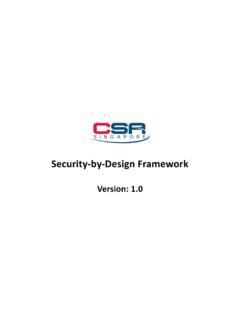Transcription of SPP of R.A. No. 9266 (The Architecture Act of 2004) 1
1 _____ The 2010 Standards of Professional Practice (SPP) Approved 27 July 2010 as the Supplemental IRR of No. 9266 (The Architecture Act of 2004 ) 1 of 94 _____ The 2010 Standards of Professional Practice (SPP) Approved 27 July 2010 as the Supplemental IRR of No. 9266 (The Architecture Act of 2004 ) 2 of 94 _____ The 2010 Standards of Professional Practice (SPP) Approved 27 July 2010 as the Supplemental IRR of No. 9266 (The Architecture Act of 2004 ) 3 of 94 STANDARDS OF PROFESSIONAL PRACTICE (SPP) Annex A Promulgated as Part of the IRR of No. 9266, known as The Architecture Act of 2004 and to be known hereinafter as the SPP Documents (replacing the 1979 UAP Docs. 201 through 208 and the UAP Docs 209 and 210) A. GENERAL DEFINITIONS 1. State shall refer solely to the National Government of the Republic of the Philippines.
2 2. Standards of Professional Practice (SPP) is a required document under Sec. 41 of No. 9266 (The Architecture Act of 2004 ) and its Implementing Rules and Regulations (IRR). 3. Commission as used for this SPP and the succeeding SPP documents shall refer only to the Professional Regulation Commission (PRC), duly created under No. 8981 (The PRC Modernization Act of 2000). 4. Board as used for this SPP and the succeeding SPP documents shall refer only to the Professional Regulatory Board of Architecture (PRBoA), duly created under No. 9266 and its IRR and under the supervision and administrative control of the Commission. 5. Architect as used for this SPP and the succeeding SPP documents shall refer only to a Registered and Licensed Architect (RLA), a natural person under Philippine law and jurisprudence with a valid certificate of registration and a valid professional identification card (representing the renewable 3-year license) for the lawful practice of the State-regulated profession of Architecture .
3 Depending on the SPP, the term Architect may also refer to Architect-of-record (Aor), Architect in charge of construction (Aicc), Consulting Architect (CA) as provided for under No. 9266. 6. Architectural Firm (AF) as used for this SPP and the succeeding SPP documents shall refer only to a juridical person under Philippine law and jurisprudence, duly registered with the Department of Trade and Industry (DTI) as a sole proprietorship for individual architectural practice or registered with the Securities and Exchange Commission (SEC) and with the Professional _____ The 2010 Standards of Professional Practice (SPP) Approved 27 July 2010 as the Supplemental IRR of No. 9266 (The Architecture Act of 2004 ) 4 of 94 Regulation Commission (the PRC or hereafter the Commission) as a professional partnership or as an architectural corporation for group architectural practice by RLAs, subject to full compliances with Sec.
4 37 of No. 9266 and derivative regulations. 7. Architect and Architectural Firm (AF) may be used interchangeably for some of the succeeding SPP. 8. Professional/s as used for this SPP and the succeeding SPP documents shall refer only to Registered and Licensed Professionals (RLPs), all natural persons under Philippine law and jurisprudence with a valid certificate and a valid professional identification card (representing the renewable license) for the lawful practice of a State-regulated profession other than Architecture . 9. Client, Owner and Project Proponent may be used interchangeably for this SPP and some of the succeeding SPP. 10. Contractor and General Contractor shall also mean Constructor or Builder, and may be used interchangeably for this SPP. 11. Bid and Tender shall mean the same. B. ACRONYMS ADR - Alternative Dispute Resolution AF - Architectural Firm ADC - Architectural Design Competition Aicc - Architect in charge of construction Aor - Architect-of-record BPO - Business Process Outsourcing CA - Consulting Architect CEC - Codes of Ethical Conduct DoLE - Department of Labor and Employment DTI - Department of Trade and Industry FPCA - Filipino Professional Consulting Architects IAPOA - Integrated and Accredited Professional Organization of Architects KPO - Knowledge Process Outsourcing MoP - Manual of Procedure PACS - Professional Architectural Consulting Services PCA - Professional Consulting Architect PRC - Professional Regulation Commission _____ The 2010 Standards of Professional Practice (SPP) Approved 27 July 2010 as the Supplemental IRR of No.
5 9266 (The Architecture Act of 2004 ) 5 of 94 PRBoA Professional Regulatory Board of Architecture SEC - Securities and Exchange Commission RLA - Registered and Licensed Architect SPP - Standards of Professional Practice TSP - Temporary/ Special Permit C. GENERAL NOTES ON THE SELECTION OF THE ARCHITECT (Part of the IRR of No. 9266, replacing the 1979 UAP Doc. 208) 1. INTRODUCTION There are many ways by which a Client can engage the services of an Architect. The most appropriate method of selecting an Architect will depend on the type and complexity of the project. 2. SCOPE OF SERVICES The scope of services will depend on the method by which the Architect is selected. 3. METHODS OF SELECTION Direct Selection is used when undertaking a relatively small project. The Client selects his Architect on the basis of: Reputation Personal or business acquaintance or recommendation of a friend Recommendation of the Architect s former Client Recommendation of another Architect.
6 Comparative Selection may be conducted by committees representing institutions, corporations or public agencies. The selection process involves: Invitation. The Client issues an invitation which includes the Terms of Reference (ToR) for the project which is based on the Design Brief prepared by another Architect. The selection committee established by the Client may consist of representatives from other State-regulated _____ The 2010 Standards of Professional Practice (SPP) Approved 27 July 2010 as the Supplemental IRR of No. 9266 (The Architecture Act of 2004 ) 6 of 94 professions and/or the construction industry, as well as persons with related expertise. Pre-qualification. Architects and/or PRC-registered Architectural Firms (AFs) submit information regarding their qualification and expertise.
7 Interview. The Architect explains his methodology in translating the plan/design requirements of the proposed project. Verification. The selection committee may visit buildings designed by the Architects and check references such as former clients and financial institutions. Evaluation & Ranking. The selection committee may adopt its own procedure in evaluating the entries and recommending the most capable firm. Negotiation. The Architect explains to the Client the Scope of Services and the Architect s Fee as prescribed under the Architect s Guidelines. An Architectural Design Competition (ADC) is used for civic or monumental projects. The competition may either be an idea competition, design or design build competition. Various Architects or architectural firms (AFs) submit plan/design solutions to a particular design problem and are judged on the basis of comparative excellence.
8 Advantages a. Opportunities will be open only to all PRC-registered and licensed Architects (RLAs) or PRC-registered Architectural Firms (AFs). b. The Client/ Committee will have a wider range of options. Disadvantages a. Process may be expensive and time consuming b. The time and effort required may discourage qualified firms from participating. _____ The 2010 Standards of Professional Practice (SPP) Approved 27 July 2010 as the Supplemental IRR of No. 9266 (The Architecture Act of 2004 ) 7 of 94 c. Some potentially unscrupulous prospective Clients will seek free services under the guise of design competition. Architects must always be constantly aware that ownership and copyright issues under Secs. 20 (4) and 33 of No. 9266 must be fully addressed under all architectural competition rules.
9 Procedure. Competitions should be conducted: a. With the assistance of the integrated and accredited professional organization of architects (IAPOA) or one of its local chapters, and b. In accordance with the Architect s Guidelines. Participants a. Sponsor or Client a natural or juridical person; b. Competitors Filipino/ Philippine-Registered and Licensed Architects (RLA) and IAPOA members in good standing. A foreign architect as a competitor must be registered in his/her country of origin and must secure a Temporary Special Permit (TSP) from the Commission (PRC), a work permit form the Department of Labor and Employment (DoLE) and must work in collaboration with a local/Filipino counterpart RLA who will assume the requisite professional responsibilities and civil liabilities, in the case of a design or design-build competition; c.
10 Professional Adviser Philippine-Registered and Licensed Architects (RLAs) who are IAPOA members in good standing; d. Jury Composed of at least five (5) members who are known for their integrity, objectivity, impartiality and honesty. Architect member in good standing of the IAPOA Competition Sponsor or Client. 4. METHOD OF COMPENSATION This will be covered by the respective type of services. _____ The 2010 Standards of Professional Practice (SPP) Approved 27 July 2010 as the Supplemental IRR of No. 9266 (The Architecture Act of 2004 ) 8 of 94 STANDARDS OF PROFESSIONAL PRACTICE (SPP) ON PRE-DESIGN SERVICES (Part of the IRR of No. 9266) SPP Document 201 (replacing the 1979 UAP Doc. 201) 1. INTRODUCTION The basic services provided by the Architect have remained relatively unchanged over the years.
